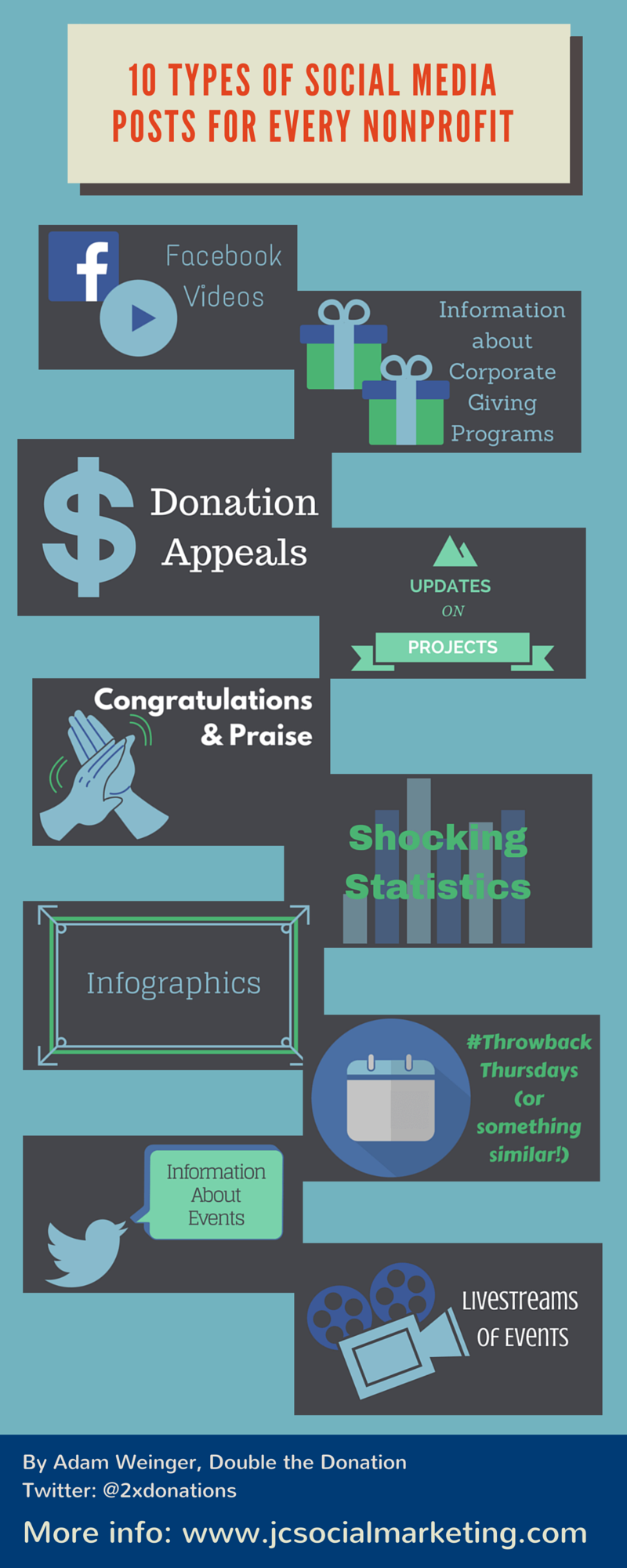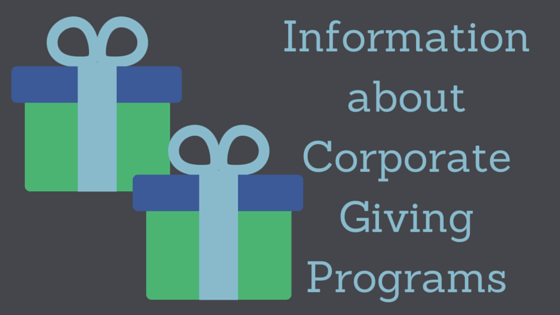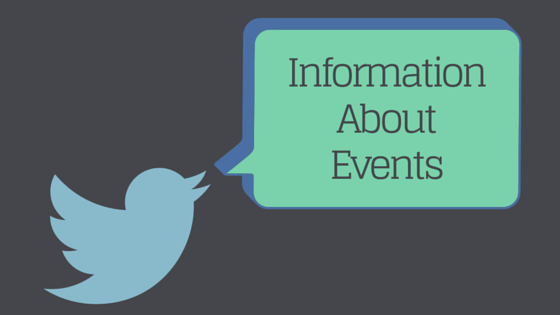 Guest blog by Adam Weinger
Guest blog by Adam Weinger
Has your organization hashtagged something recently?
Have you looked at how many Facebook posts you’re creating each week?
Do you know how many Twitter followers you have?
If the answers to these questions are ambiguous, vague, or nonexistent, it may be time to rethink your nonprofit’s social media strategy.
That can be an intimidating sentence to nonprofit professionals who aren’t really sure what the difference is between repinning and hashtagging or how many characters there are in a tweet.
Thankfully, we’ve got a quick guide to the types of social media posts you should be sharing with your supporters.
Here’s a sneak peek of what we’ll be covering in this article:
- Facebook Videos
- Information About Corporate Giving Programs
- Donation Appeals
- Updates on Projects
- Congratulations & Praise
- Shocking Statistics
- Infographics
- #ThrowbackThursdays (or something similar!)
- Information About Events
- Livestreams of Events
Check out the ten essential social media posts your organization should be sending out to donors and volunteers.
And while you’re at it, check out the three keys to social media success!
1. Facebook Videos

Videos are a great way to show your followers tangible evidence of their support.
Whether you upload a time-lapsed video of the construction of a new building or an interview with someone who has been affected by your nonprofit, videos can be powerful tools for nonprofits.
Native videos (i.e., videos that are uploaded directly to Facebook and aren’t linked from YouTube, Vimeo, or elsewhere) are some of the most popular content on Facebook. Their success is due to the fact that they are often behind-the-scenes glimpses into a nonprofit.
Picture this: you’re a volunteer that’s just helped clean up a local river. You worked for a few hours one weekend but couldn’t volunteer past that.
You still want to know how the project ended up, though. If the nonprofit you worked with uploaded a video of highlights of the entire experience, you’d be able to see the effect of your personal contribution as well as the volunteer hours of others.
If you post videos on Facebook, you’ll be able to more effectively connect with your supporters and show them how you’re making a difference.
2. Information About Corporate Giving Programs

Many of your donors and volunteers likely work for companies that have extensive corporate philanthropy programs.
While some of your supporters might know about these programs and submit matching gift requests and volunteer grant forms on a regular basis, many more might not know that these programs even exist!
Your nonprofit’s job as far as corporate philanthropy and social media are concerned is to get the word out!
What does this look like in practicality?
- Post statuses with eye-catching graphics and pictures that remind donors to submit matching gift requests to their employers.
- Tweet links to matching gift information on your “Ways to Give” page.
- Upload a picture of your volunteers to Instagram with a caption that talks about volunteer grants.
- And more. The options are endless!
By sharing information about corporate giving programs, your nonprofit has the potential to benefit monetarily from your volunteers’ hard work and double the contributions of your donors.
3. Donation Appeals

Your nonprofit can’t survive off of retweets and likes. You need donations to keep the engines running.
You’re likely asking for donations from a variety of sources, so why not use social media as one of those avenues
Make sure that you include a link to your donation page within your post or picture so that donors can readily give online.
The key to asking for donations on social media is to space them out. You don’t want to annoy or overwhelm your followers with a string of donation appeals that never ends.
Instead, intersperse your fundraising asks with other updates and posts, such as:
- Information about your fundraising events.
- Opportunities to get involved.
- Success stories.
- General nonprofit updates.
This way, your followers can connect to your organization in ways that don’t just involve their wallets.
Asking for donations on social media can be an easy and cost-effective way to get in touch with a multitude of donors.
4. Updates on Projects

Your donors want to know about your organization. How will they know what’s going on unless you tell them
There are two sides to this social media coin.
On one side, you don’t want to overwhelm your donors with information. If you post a status every hour, on the hour, donors will eventually start tuning you out and ignoring your posts (especially if all those posts are basically the same!).
On the other side, you can’t just update donors on one project and think that your bases are covered.
Strike a balance and keep your followers engaged with pertinent information without overwhelming or ignoring them.
For example:
- Upload images of your capital campaign’s kickoff event and remind people of how they can donate.
- Stick to a regular schedule of posting updates for different projects. Show all of your endeavors the attention they deserve.
- Give donors information about your nonprofit’s general operations. If you bring on a new board member, highlight them in a post.
- And more!
Updating your followers in various ways on social media will help you engage with them and keep them in the loop!
5. Congratulations & Praise

Nearly everyone enjoys being in the limelight from time to time.
While there are any number of ways for your nonprofit to congratulate your biggest supporters, social media can be a quick and easy way to congratulate and praise your donors and volunteers.
Here are a few of the ways social media can help:
- Post pictures of a standout volunteer who has faithfully served your organization.
- Try a “Donor of the Week” update where you highlight your major gift donors, new supporters, and everyone in between!
- Tag supporters in images and videos and let your followers know just how great they are.
- If a loyal donor or volunteer passes a milestone (i.e., supporting your organization for a certain number of years or volunteering for a set amount of hours), let your social media networks know!
Your supporters will appreciate the recognition, and you might pick up a few new followers as well!
Sending out congratulatory messages and praising your donors and volunteers is a great way to show them you value their contributions of money and time.
6. Shocking Statistics

If your nonprofit wants to grab the attention and encourage more people to donate to your cause, post some statistics on your social media sites.
These statistics should cause some kind of reaction, either positive or negative.
For instance, if your organization is focused on animal welfare, you could:
- Share a statistic about how many animals are neglected each year across the United States.
or
- Let followers know how many pets your organization rescued in the past month.
See how each statistic could produce a different reaction?
However, both of them should be centered around your organization, the work you do, and the animals, individuals, and communities that you help.
Followers who see these statistics (especially if they’re paired with emotional photos) might be moved to give to your organization. Therefore, you should also include a call to action that encourages followers to donate (don’t forget the link to your donation page!).
Posting shocking statistics every once in awhile is a good way to keep your followers updated on the work you do and remind them of how much more needs to be accomplished.
7. Infographics

Many of your social media followers will be visual learners, meaning they process information more effectively when it’s presented as a graphic, chart, or image.
Infographics are a great way to display the statistics I mentioned in the previous point, but they’re also extremely effective for conveying large amounts of information.
Did your nonprofit just launch a campaign with many different components?
Use an infographic to show the different facets of the undertaking.
Did your organization conduct a study or survey?
Display the findings in a well-organized infographic.
Have you recently expanded your efforts internationally?
Map out your nonprofit’s reach with an infographic.
Infographics allow your followers on social media to easily digest information that would otherwise get tuned out.
If you have a lot of information that you want to get in front of donors’ eyes, consider using an infographic to get the message across.
8. #ThrowbackThursdays (or something similar!)

If you’ve spent any time on social media at all, you’ll know that nearly each day has a corresponding theme and hashtag.
For instance:
- #ManCrushMonday (#mcm) or #MotivationMonday
- #TransformationTuesday
- #WomanCrushWednesday (#wcw)
- #ThrowbackThursday (#tbt)
- #FridayFunday
- #SocialSaturday
- #SelfieSunday
These hashtags are universal and can be found on Facebook, Twitter, Instagram, and more.
How can your nonprofit get in on this trend?
Easy! Simply start by posting relevant content that corresponds to the daily theme.
For instance, you could post:
- An inspirational quote on #MotivationMonday
- A before and after pic of a project on #TransformationTuesday
- A picture of a female volunteer or staff member who went above and beyond on #WomanCrushWednesday
- An image of a community you helped before the transformation on #ThrowbackThursday
- A goofy picture of your staff members on #FridayFunday
- Anything you want that is easily shared on #SocialSaturday
- A selfie of someone that your nonprofit helped on #SelfieSunday
These are just a starting point! New themes and hashtags are always bound to pop up. Keep your finger on social media’s pulse and start hashtagging!
9. Information About Events

Social media is the perfect communication method for getting the news out about events and fundraisers that your nonprofit hosts.
If you need to quickly remind followers that “Hey! Our event is tomorrow at 5 p.m.!” you can simply:
- Send out a tweet.
- Write up a post.
- Upload a photo or video.
You can even use social media to invite people to events. Facebook makes this easy by allowing nonprofits to create events and then send out invitations to people who have liked the page.
The important part about posting event information on social media is to keep it consistent. If you have a gala in March, you’ll need to do more than tweet about it in January.
Space your posts out in the months leading up to your fundraiser or event.
That way, donors and followers are always in the loop!
10. Livestreams of Events

And speaking of events…
If you have some attendees that couldn’t make it to your event, put up a livestream on one of your social media platforms!
YouTube is the most obvious avenue for this, but if you don’t have many subscribers, you can use Facebook for the same function.
A livestream allows those who were unable to attend your event get in on the action. It’s perfect for reaching donors who might live across the country or around the world.
The best part about placing a livestream of an event on social media is that your followers can still interact as if they were at the event themselves.
YouTube and Facebook alike allow followers to post comments and interact with the organization and each other during the livestream.
This way, no one feels left out! Just make sure you have a designated staff member handling the livestream to answer comments and questions from supporters who aren’t in physical attendance.
Livestreams are a great way to interact with your followers during an event — even if they aren’t there!
——
There are countless other posts that your nonprofit could send out on social media. But these ten are a good starting point if you want to gain more followers and engage with your existing supporters!
What about your organization? What types of social media posts have you found to be successful? Let us know in the comments!
About the author: Adam Weinger is the President of Double the Donation, the leading provider of employee matching gift tools and services to nonprofits. Have questions about matching gifts or Double the Donation’s service? You can connect with Adam on LinkedIn, Twitter, or via email.
Comments 3
Great ideas and information Adam.
The Steve Harvey Harvey Foundation use recorded video and live video extremely well across several social media channels including Facebook, Periscope and Youtube.
The way he uses video to thanks his donors, get his foundation’s message across, and instructs people how to donate is incredible.
You can see examples on his foundation’s facebook page here:
https://www.facebook.com/HarveyFoundation/
Author
Thank you for this info Steve – I am going to contact the Harvey Foundation to see if they would discuss their video strategy!
No problem Julia. I’m glad to be of some help. 🙂